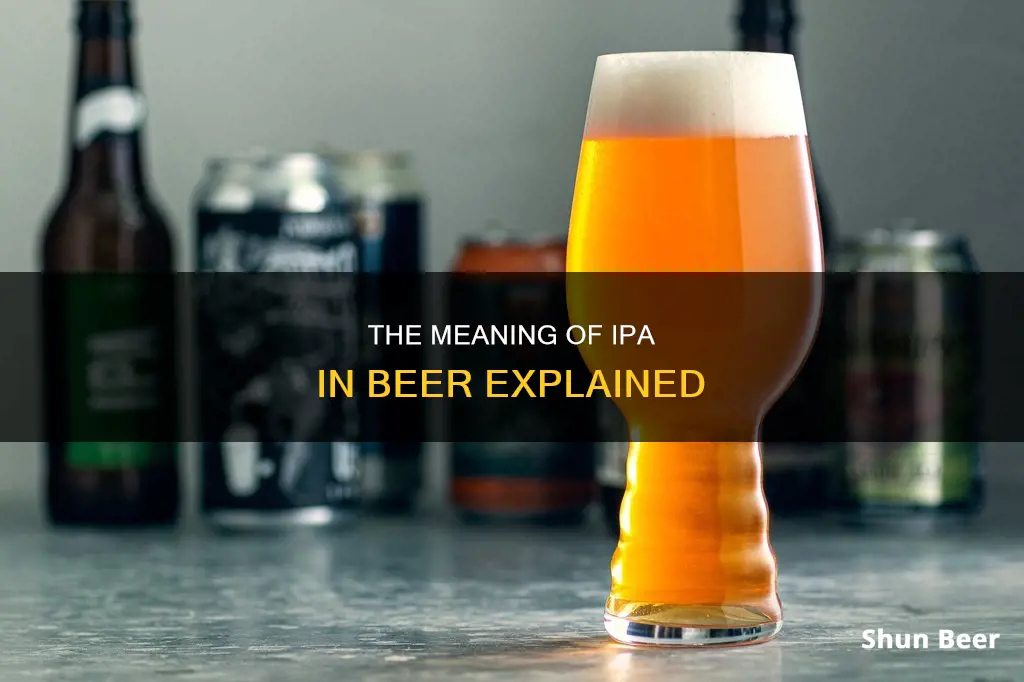
India Pale Ale, or Indian Pale Ale, is a hoppy beer style within the broader category of pale ale. The IPA trend has swept the nation and shows little sign of slowing down, but what does IPA stand for in beer? During British colonial times, sailors sought a beer recipe that would be easy to preserve on long trips from Britain to India. The IPA beer has come a long way since colonial times, but the hoppy quality has mostly remained the same.
What You'll Learn

IPA stands for Indian Pale Ale or India Pale Ale
IPA is an acronym that stands for Indian Pale Ale or India Pale Ale. The drink gets its name from its historical origins during the British colonial era. British sailors on long voyages to India needed a beer that could withstand the changing temperatures and humidity during the six-month journey. They found that brewing a beer with lots of hops helped to preserve it for longer, preventing it from going bad. Thus, the India Pale Ale was born!
The IPA has come a long way since its colonial origins. While the hoppy quality remains, the beer is now enjoyed fresh and cold rather than after a long journey at sea. Modern IPAs tend to have an ABV of around 6-7%, although this can vary depending on the style and brewing techniques used.
There are several different styles of IPAs, each with its unique characteristics. The West Coast IPA, for example, is known for its fruity, rowdy flavours and crisp, clean body. On the other hand, the New England IPA is unfiltered, hazy, and has very low bitterness due to the use of blends of hops that lend intense fruity flavours.
The IPA is a versatile style of beer that has gained immense popularity in recent years. Its bold and distinctive taste has made it a favourite among craft beer enthusiasts worldwide. Whether you prefer a traditional West Coast IPA or a hazy New England IPA, there is an IPA style to suit every taste.
The IPA has a rich history and a dedicated following. It has evolved over the years, with brewers constantly creating new variations and exploring different hop varieties to augment flavour and create unique profiles. The IPA is a testament to the creativity and innovation of brewers worldwide.
Guinness Beers: Exploring the Diverse Range of Stouts
You may want to see also

IPAs are best enjoyed fresh and cold
IPAs, or Indian Pale Ales, are best enjoyed fresh and cold. The ideal temperature for an IPA is around 50 degrees Fahrenheit, which is much warmer than a beer pulled directly from the fridge. Allowing the beer to warm up a little will enhance its flavour and reveal its more delicate aromas.
IPAs are known for their bitter taste, which comes from their higher hops content. The beer originated in the 18th century during British colonial times. Sailors were looking for a beer recipe that would be easy to preserve on long trips from Britain to India. They brewed a beer with lots of hops that could survive long journeys without going bad, and thus, the India Pale Ale was born.
Today, IPAs are enjoyed all over the world and come in a range of styles, including West Coast, New England, Session, Double or Imperial, and British IPAs. Each style has its own unique flavour profile and alcohol content. For example, West Coast IPAs are known for their hoppy, fruity, and crisp taste, while New England IPAs are hazy and have intense fruit flavours. Session IPAs are perfect for those who want the flavour of an IPA but with a lower alcohol content.
For the best IPA experience, it is recommended to drink the beer within the first three weeks of production. However, it is still safe to drink an IPA four to five weeks after production. So, whether you're a longtime IPA fan or a newcomer to this style of beer, remember that IPAs are best enjoyed fresh and cold to truly appreciate their complex flavours and aromas.
The Mystery of Floating IPA Beer Bits
You may want to see also

There are 10 styles of IPAs
India Pale Ale, or IPA, is a style of pale ale that emphasizes hop flavours and aromas. The name has its roots in the British Empire and their colonies, but the beer has evolved into its own unique style. IPAs are typically heavily hopped, with a higher ABV, making them best enjoyed fresh and cold.
There are indeed 10 styles of IPAs, and they are:
- Session IPA: These are IPAs with a lower alcohol content, usually below 5% ABV. They are thinner in body and can be drunk repeatedly.
- Double/Imperial IPA: These are stronger IPAs with a higher hop concentration and more malt, resulting in a higher ABV (over 7%).
- Dry-Hopped: This process involves steeping hops in fermenting beer rather than boiling them, creating a strong aroma without adding bitterness.
- Single-Hopped: Using one type of hop, instead of a variety, to bring a specific flavour to the beer.
- Fresh-Hopped: Also called wet-hopped or harvest ales, these IPAs are only available during the hop harvesting season in late summer. The hops go straight from the vine to the brewery and into the boil within 24 hours.
- West Coast IPA: This style is inspired by British IPAs but uses American hops, resulting in a huge citrus aroma with pine and weed-like notes. They are less dry and more bitter than their British counterparts.
- East Coast IPA: Similar to the West Coast style but with a fundamental difference – yeast. East Coast IPAs use mutated, complicated British yeasts that produce lots of flavours and aromas, such as stone fruit, banana and tropical notes.
- New England IPA: This style is unfiltered, making it hazy, and has very low bitterness. It often has intense, fruity flavours and is dry-hopped.
- Belgian IPA: A hybrid style inspired by American IPAs but made with Belgian yeast strains, resulting in sweet, bready, and warm notes.
- Black IPA: Also known as a Cascadian Dark Ale, this style aims to combine the appearance of a stout with the aroma of a West Coast IPA and the taste of something in between.
So, there you have it – 10 unique styles of IPAs, each with its own distinct characteristics and flavours. Cheers to that!
Marble Magic: Guinness Beer's Signature Swirl
You may want to see also

IPAs are known for their bitter quality
IPAs, or India Pale Ales, are known for their bitter taste. However, the level of bitterness varies between different types of IPAs. The bitterness of an IPA depends on the brewing process and the types of hops used.
The bitterness of an IPA is measured using the International Bittering Units (IBU) scale, which typically ranges from 1 to 100, with some beers reaching up to 1,000 IBUs. A lower IBU indicates a less bitter IPA, and anything over 45 IBUs is considered more bitter. The addition of hops, which are the flowers of the female plant Humulus lupulus, contributes to the bitterness of an IPA. Hops have been used in beer since 822 AD and are a crucial ingredient that counteracts the sweetness of malt grain.
The timing of hop addition during the brewing process also affects the bitterness of an IPA. When hops are added early in the brewing process, the beer tends to be more bitter. This is because hops act as a preservative, and the longer they are in the beer, the more bitter it becomes. This is why British IPAs, which were brewed with a large amount of hops to survive long journeys, are known for their bitter taste.
However, modern IPAs, such as the West Coast and New England styles, have found a way to balance the bitterness with fruity, floral, and crisp flavours. The West Coast IPA explores the fruity flavours of hops while retaining some bitterness, resulting in a clean, crisp body with higher carbonation and tropical fruit notes. On the other hand, the New England IPA is unfiltered and has extremely low bitterness due to the use of hop blends that lend intense fruity flavours.
While IPAs are known for their bitterness, it is important to note that not all IPAs are overly bitter, and the modern approach to hoppy beer is to emphasise the fruity flavours that hops can provide. Additionally, the perception of bitterness can vary among individuals, and factors such as serving temperature and freshness can also impact the bitterness experienced in an IPA.
Guinness Beer Widget: What's Its Purpose?
You may want to see also

The average ABV on an IPA is 5-7%
India Pale Ale, or IPA, is a style of beer that is typically hoppy and has an ABV of around 5-7%. The ABV, or alcohol by volume, of a beer is a metric used to determine the alcohol content of the beverage. It shows what percentage of the beverage's total volume is pure alcohol.
The ABV of beer varies depending on the type, and while IPAs tend to have a higher ABV than some other types of beer, there are outliers. Some IPAs have an ABV of over 10%, while some beers have an ABV of less than 1%. The ABV of a beer affects factors such as taste and the likelihood of intoxication, so it is important to be aware of the ABV when consuming alcoholic beverages.
Session IPAs, which are designed to have a lower ABV than typical IPAs, usually have an ABV of around 4.5-5%. On the other hand, Double or Imperial IPAs tend to have a higher ABV of 8% or more, and Triple IPAs are usually closer to 10% or higher.
While the average ABV of an IPA is around 5-7%, it's important to note that this can vary depending on the specific beer and the brewer's preferences.
Guinness Beer and Caffeine: What's the Connection?
You may want to see also
Frequently asked questions
IPA stands for Indian Pale Ale or India Pale Ale.
During British colonial times, sailors needed a beer recipe that would be easy to preserve on long trips from Britain to India. The weather in India was too hot and humid to brew good beer. So, the sailors brewed a beer with lots of hops that could survive long journeys without going bad.
There are several types of IPAs, including West Coast IPA, New England IPA, Session IPA, British IPA, Double IPA or Imperial IPA, and Triple IPA.
The ABV (alcohol by volume) of an IPA can vary depending on the type. Lower ABV IPAs typically hover around 5%, while IPAs created with a different brewing process may be 7% or higher.
IPAs are known for their bitter quality due to the higher-than-average amount of hops they contain. They also have fruit and citrus notes, such as grapefruit and orange, and earthier notes like pine.







